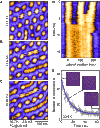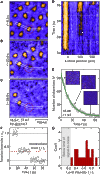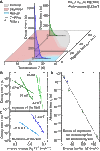Entropy-limited topological protection of skyrmions
- PMID: 28975152
- PMCID: PMC5621974
- DOI: 10.1126/sciadv.1701704
Entropy-limited topological protection of skyrmions
Abstract
Magnetic skyrmions are topologically protected whirls that decay through singular magnetic configurations known as Bloch points. We used Lorentz transmission electron microscopy to infer the energetics associated with the topological decay of magnetic skyrmions far from equilibrium in the chiral magnet Fe1-x Co x Si. We observed that the lifetime τ of the skyrmions depends exponentially on temperature, [Formula: see text]. The prefactor τ0 of this Arrhenius law changes by more than 30 orders of magnitude for small changes of the magnetic field, reflecting a substantial reduction of the lifetime of skyrmions by entropic effects and, thus, an extreme case of enthalpy-entropy compensation. Such compensation effects, being well known across many different scientific disciplines, affect topological transitions and, thus, topological protection on an unprecedented level.
Figures




Similar articles
-
Deformation of Topologically-Protected Supercooled Skyrmions in a Thin Plate of Chiral Magnet Co8Zn8Mn4.Nano Lett. 2017 Mar 8;17(3):1637-1641. doi: 10.1021/acs.nanolett.6b04821. Epub 2017 Feb 2. Nano Lett. 2017. PMID: 28135106
-
Statistical Thermodynamics of Chiral Skyrmions in a Ferromagnetic Material.Materials (Basel). 2019 Nov 9;12(22):3702. doi: 10.3390/ma12223702. Materials (Basel). 2019. PMID: 31717604 Free PMC article.
-
Transformation between meron and skyrmion topological spin textures in a chiral magnet.Nature. 2018 Dec;564(7734):95-98. doi: 10.1038/s41586-018-0745-3. Epub 2018 Dec 5. Nature. 2018. PMID: 30518889
-
Current-Induced Nucleation and Annihilation of Magnetic Skyrmions at Room Temperature in a Chiral Magnet.Adv Mater. 2017 Jun;29(21). doi: 10.1002/adma.201606178. Epub 2017 Mar 29. Adv Mater. 2017. PMID: 28370455
-
Electrical manipulation of skyrmions in a chiral magnet.Nat Commun. 2022 Mar 24;13(1):1593. doi: 10.1038/s41467-022-29217-4. Nat Commun. 2022. PMID: 35332156 Free PMC article.
Cited by
-
Giant antidamping orbital torque originating from the orbital Rashba-Edelstein effect in ferromagnetic heterostructures.Nat Commun. 2018 Jul 2;9(1):2569. doi: 10.1038/s41467-018-05057-z. Nat Commun. 2018. PMID: 29967453 Free PMC article.
-
A micromagnetic theory of skyrmion lifetime in ultrathin ferromagnetic films.Proc Natl Acad Sci U S A. 2022 Jul 19;119(29):e2122237119. doi: 10.1073/pnas.2122237119. Epub 2022 Jul 11. Proc Natl Acad Sci U S A. 2022. PMID: 35858324 Free PMC article.
-
Enhanced thermally-activated skyrmion diffusion with tunable effective gyrotropic force.Nat Commun. 2023 Sep 11;14(1):5424. doi: 10.1038/s41467-023-40720-0. Nat Commun. 2023. PMID: 37696785 Free PMC article.
-
Estimating the effective fields of spin configurations using a deep learning technique.Sci Rep. 2021 Nov 25;11(1):22937. doi: 10.1038/s41598-021-02374-0. Sci Rep. 2021. PMID: 34824339 Free PMC article.
-
Electrically powered motions of toron crystallites in chiral liquid crystals.Proc Natl Acad Sci U S A. 2020 Mar 24;117(12):6437-6445. doi: 10.1073/pnas.1922198117. Epub 2020 Mar 11. Proc Natl Acad Sci U S A. 2020. PMID: 32161127 Free PMC article.
References
-
- Constable F. H., The mechanism of catalytic decomposition. Proc. R. Soc. Lond., Ser. A 108, 355–378 (1925).
-
- Meyer W., Neldel H., Concerning the relationship between the energy constant epsilon and the quantum constant alpha in the conduction-temperature formula in oxydising semi-conductors. Phys. Z. 38, 1014–1019 (1937).
-
- Cooper A., Johnson C. M., Lakey J. H., Nöllmann M., Heat does not come in different colours: Entropy–enthalpy compensation, free energy windows, quantum confinement, pressure perturbation calorimetry, solvation and the multiple causes of heat capacity effects in biomolecular interactions. Biophys. Chem. 93, 215–230 (2001). - PubMed
-
- Peacock-López E., Suhl H., Compensation effect in thermally activated processes. Phys. Rev. B 26, 3774–3782 (1982).
Publication types
Grants and funding
LinkOut - more resources
Full Text Sources
Other Literature Sources

